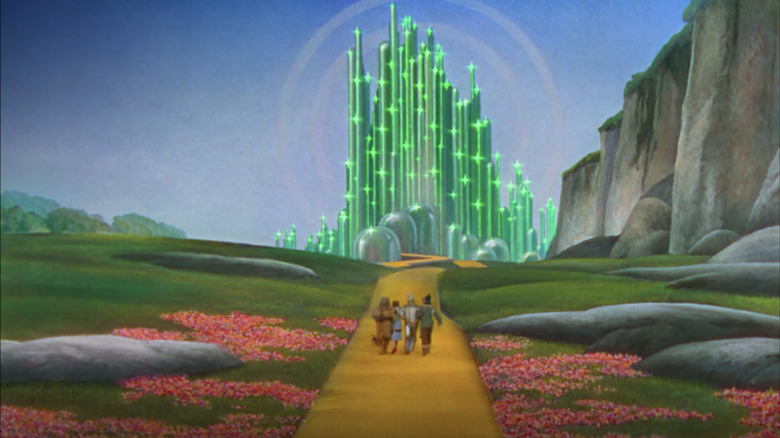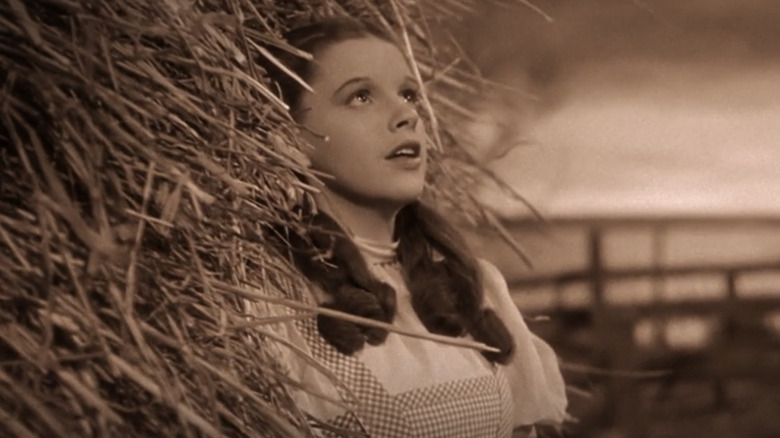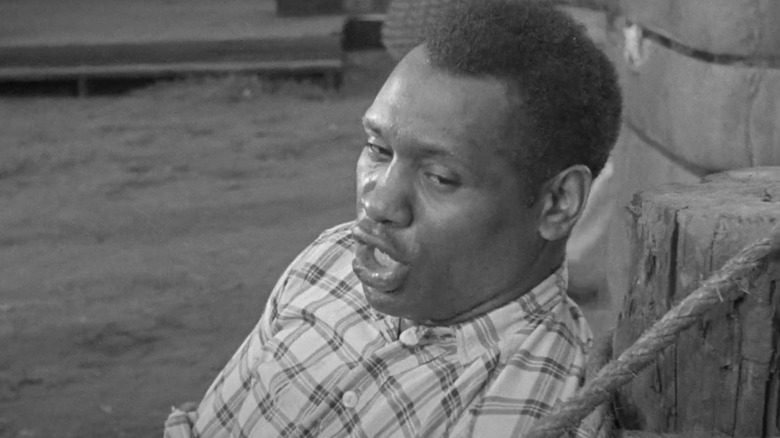The Wizard Of Oz Almost Premiered Without Its Signature Song
Look, it is no secret that some people in charge of making movies have very little sense about what makes a good movie. Sometimes they really want their son to be a movie star, and sometimes they just desperately want a giant mechanical spider in a movie. A lot of these big wigs are only thinking about how to get the most butts in seats and eagerly want them to return to those seats time and time again. There are too many tales of movies being undermined by studio heads and producers, and not everyone has the opportunity to go back and fix them like Ridley Scott. So when people like this have a terrible idea that would truly tarnish a movie and their bad ideas end up not hurting the film, it is a minor miracle.
One of the great classics in the history of Hollywood cinema almost fell prey to this interference. "The Wizard of Oz" was one of MGM's crown jewels of 1939. The Technicolor musical adaptation of L. Frank Baum's work has delighted viewers of every age for over 80 years. Much of its beauty has not been matched on screen since. However, MGM wanted to eliminate one of the film's finest moments, which would have erased an indelible cinematic scene and song that has become one of the most memorable moments in film history. They wanted to get rid of "Over the Rainbow."
No need to taste the rainbow
That's right. One of the great songs of the 20th century, written by composer Harold Arlen and lyricist Yip Harburg, nearly never saw the light of day. Louis B. Mayer and the other MGM higher ups believed that the opening sequence of the film in Kansas was taking too long. As the vivid Technicolor of Oz was the selling point, it was thought that the ballad kicking off the film would bore children to tears. Associate producer Arthur Freed, who just so happened to be a pretty talented songwriter himself, had to step in and gave Mayer the ultimatum of, "The song stays — or I go." Thankfully, sense prevailed, and the song stayed in the picture. Oh, yeah, and it also won the Academy Award for Best Original Song.
"Over the Rainbow" could not be more important to the power of "The Wizard of Oz." The song is a classic "I want" song, meaning it serves to explain the character's hopes and dreams to set them on their quest. Judy Garland's performance of the song, as directed by King Vidor (credited director Victor Fleming had taken over the troubled production of "Gone with the Wind" by that point), is one of those scenes burned into the brains of every person who sees it. The scene only features four cuts, making way for a brief close-up of the dog Toto and the sky, and Garland holds that frame as only the best movie stars can. Without this scene, there would be no reason to care for Dorothy's journey into the fantastical world of Oz. All it would be is spectacle. Spectacle is fine and dandy, but if there's no character truth underneath that spectacle, the film would simply feel empty. We would look back at "The Wizard of Oz" as a technological triumph rather than an artistic one.
Book musicals were still new
When "The Wizard of Oz" was released, the world had a very different understanding of what a musical was compared to today. Today, musicals are generally all "book musicals." These are shows where the music is used to advance the plot and characters, where the content of each song is inextricably tied to the scene. If you were to remove one of these songs from the show, the story would no longer make sense. In 1939, this way of telling a story was still a very new concept and had not been done that often.
The first proper American book musical produced was "Show Boat" in 1927 (seen above) from book writer and lyricist Oscar Hammerstein II and composer Jerome Kern. Before "Show Boat," musicals (or "musical comedies" as they were more commonly known) were light entertainments that were sort of a mish-mash of revues by popular songwriters, dance set pieces, and vaudeville. Scenes in these shows existed as an excuse to transition to another musical number. These are the kinds of shows the Hollywood movie musicals were based on, and it took a long, long time before they really started to progress to where the book musical was headed, due in large part to Hammerstein and Richard Rodgers' blockbuster show "Oklahoma!" in 1943.
Between the debut of "Show Boat" on Broadway and the making of "The Wizard of Oz," the only proper example of the book musical on film was the 1936 film adaptation of "Show Boat" directed by James Whale. So the notion of a song being utilized for plot and character reasons was not really something people would have considered. The higher-ups at MGM were still looking at the musical numbers as their own discreet entities designed for maximum toe-tapping and wonder. "Over the Rainbow," while a very memorable melody, does not function that way. It is a song born out of the book musical tradition established by "Show Boat," and it's a rather revolutionary moment for translating that art form to the big screen. While the rest of the songs in "The Wizard of Oz" are more upbeat and conventionally fun, they are also book songs, integral to telling the film's story and exploring its characters and themes.
"Over the Rainbow" getting cut from "The Wizard of Oz" would have been a travesty. When Arthur Freed put his foot down about the matter, Louis B. Mayer relented and said, "Let the boys have the damn song. Put it back in the picture. It can't hurt." That song does more than not hurt — it gives the film life. "The Wizard of Oz" needs "Over the Rainbow" like "Citizen Kane" needs "Rosebud." Without it, I don't know how much we would still be trying to mine this movie for all it's worth after all these decades. And we wouldn't have one of the greatest song covers of all time.


